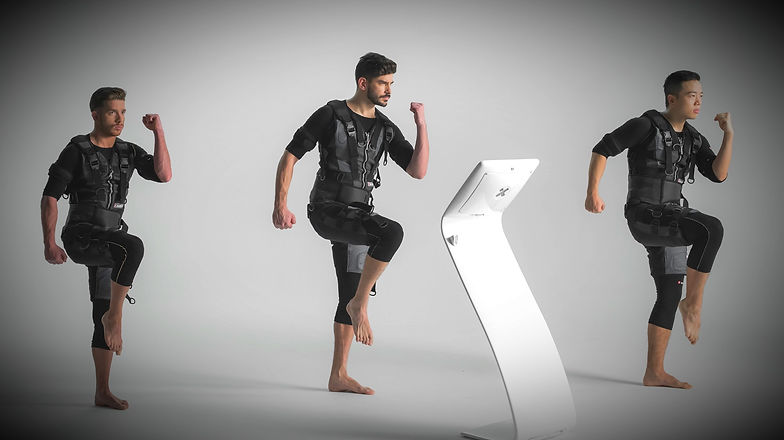
ems
ELECTRO-MUSCLE-STIMULATION
EMS stands for “Electrical Muscle Stimulation” and it amplifies our own muscular contraction whereby our central nervous system constantly sends electrical impulses to control our muscular action. The electrical impulses (generated by the EMS device) allow the triggering of action potentials on motoneurons of motor nerves (excitations). These excitations of motoneurons are transmitted to the muscle fibers via the motor endplate where they generate mechanical muscle fiber responses that correspond to muscle work. Depending on the parameters of the electrical impulses (pulse frequency, duration of contraction, duration of rest, total session duration), different types of muscle work can be imposed on the stimulated muscles. So you can say it is a natural impulse intensified in order to reach deeper muscle layers and all of our muscle fibers at the same time, which are hard to activate through conventional training. EMS training achieves optimum results with minimum input time. A 20-minute EMS training session replaces five training sessions with conventional fitness equipment. Briefly, THE EMS LAB training offers an ultimate experience that is full of privacy.
more about
The Technology Behind EMS
How does Electro Muscle Stimulation (EMS) work?
In everyday life, your body stimulates muscles naturally by sending bio-electrical pulses down the spinal cord and into your nerve fibers. Muscles need this stimulation in order to move.
Electro Muscle Stimulation (EMS) is nothing more than an amplification of the body’s own electrical pulses.
The extra stimulus causes your muscles to contract more and work harder.
Combining EMS with exercise is a very targeted way of super-charging the effects of your workout. Deep muscles are stimulated far more effectively than through conventional exercise alone, making every move stronger and delivering visible improvements more quickly.

The History of EMS
From humble beginnings to the training phenomenon it is today, EMS has had a long and interesting journey. In the middle of the eighteenth-century physicists laid the foundations for today’s physical therapy. However, the milestone in the direction of EMS as a training method was achieved only by the Italian physician and anatomy scientist Luigi Galvani in 1780. By the 1990s EMS, as we recognize it today, was born and was becoming a regular feature both in fitness workouts and physiotherapy. Now EMS is used as a part of a workout for athletes and professionals looking to get fit in half the time.
EMS
BENEFITS OF
electro-muscle-stimulation

1. Assists strengthening muscles
With the help of EMS, muscle fibers are mobilized causing a larger number of muscle fibers to be contracted
2. WB-EMS Training is a convenient and time-efficient way to maintain or increase muscle mass.
To achieve this, WB-EMS technology enables to stimulate the main muscle groups of the human body simultaneously. These muscle groups are the trunk muscles (abdominal, pectoral and back muscles), arm muscles (biceps, triceps, deltoids) and leg muscles (glutes, quads) all at the same time.
3. Improves muscle tone and strength by stimulating deep muscle fibers
Through the use of special settings including pulse width – deep muscle fibers are stimulated
4. Decrease body fat % and helps in weight control
By using cardio and strength program we achieve a higher calorie burning effect
Calories are burnt in significant amount only when most of the body is involved in physical exercise
During WB-EMS several muscle groups, the heart and the respiratory system are all engaged at once
5. Facilitates the fight against cellulite
Thanks to increased local blood circulation skin could be more firm, smooth the subcutaneous tissues and removes harmful metabolites, thus help to fight against cellulite
6. Increased muscle tone throughout the core decreases back problems and increased muscle strength helps to achieve proper posture
The muscles besides the spine get stronger and the pains due to the weak stabilizing muscles can be eliminated
Eliminate muscle imbalances by using special settings - pulse width, intensity - and the electric impulses can make the deeper stabilizing muscles work as well
7. Rehabilitation and Joint-friendly training
Helps with rehabilitation when injuries prevent other types of workouts by maintaining muscle tone
Targeted muscle-volume training, the strain on the joints known from the trainings done with weights disappears
8. Helps in getting back into shape after childbirth and Increased metabolic rate
By using cardio and strength program you achieve a higher metabolism
By increasing of local blood and lymph flow
